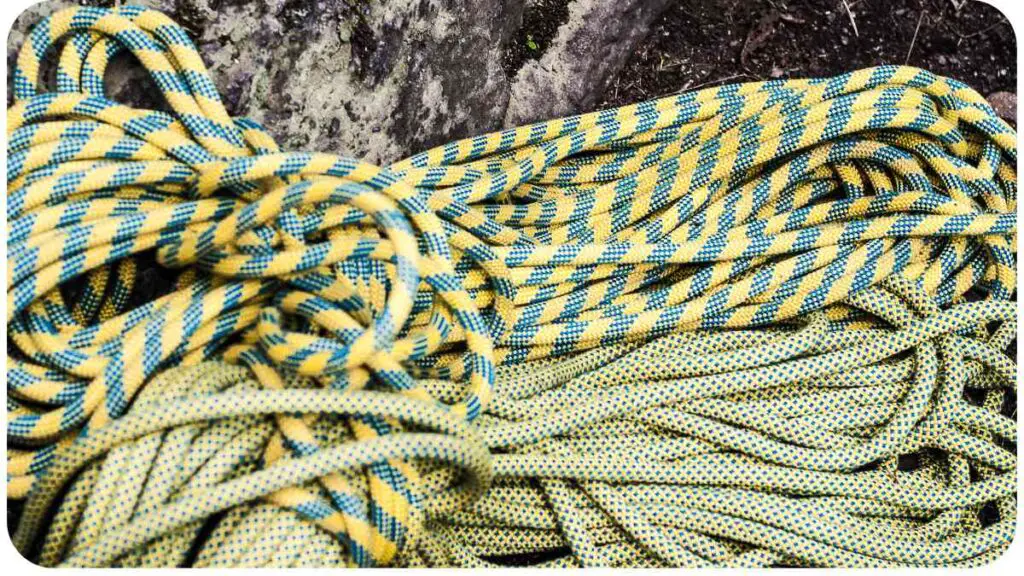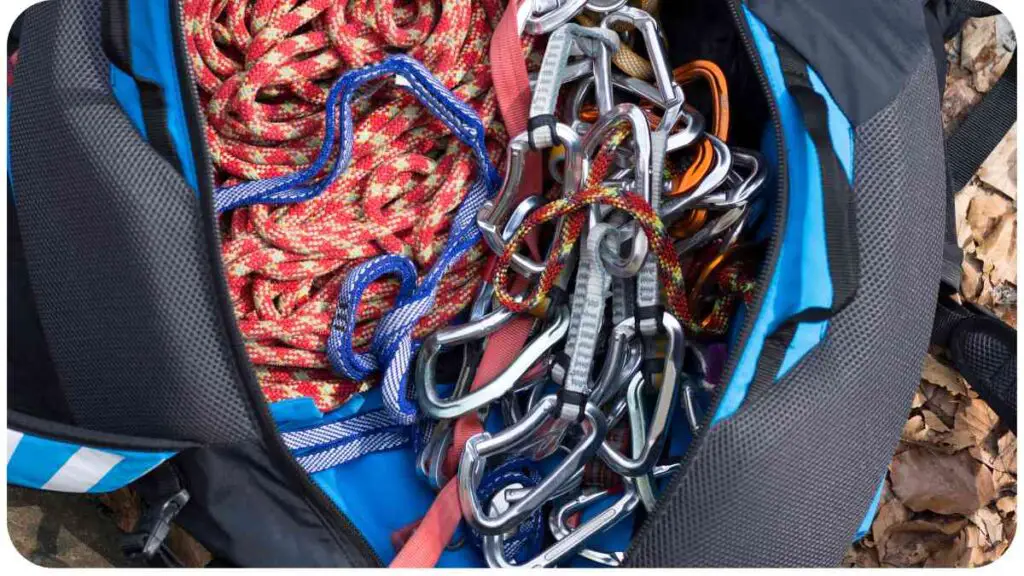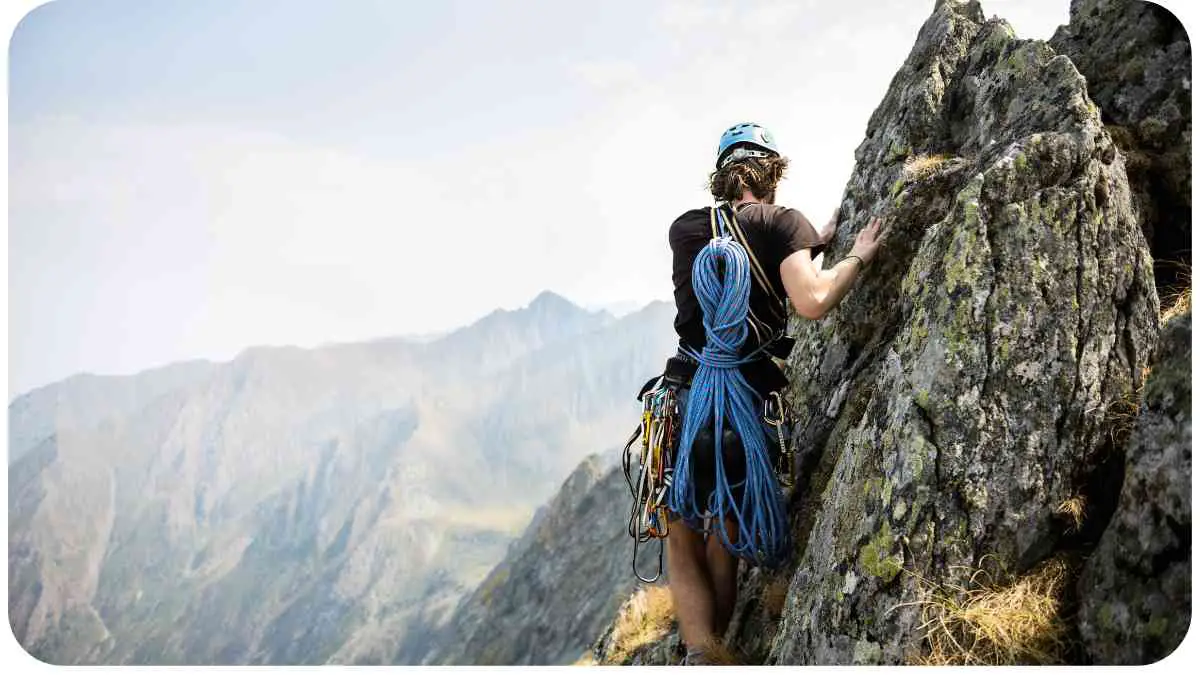As climbers, we know that having reliable gear is crucial for our safety and performance on the wall. Among all the equipment we use, climbing ropes play a vital role. However, after a wet climbing session or outdoor adventure, your rope is likely to be damp or completely wet.
To ensure the longevity and performance of your rope, it’s essential to follow the best practices for drying and storage. In this article, we will explore the expert techniques, practical tips, and innovative solutions for properly drying and storing your wet climbing rope.
| Takeaways |
|---|
| Proper drying and storage of climbing ropes are crucial for their longevity and performance. |
| Avoid bundling up the rope tightly after use to allow proper drying. |
| Choose a storage area that is dry, well-ventilated, and away from direct sunlight. |
| Regularly inspect the rope for signs of wear, fraying, or damage. |
| Clean the rope using mild soap or a dedicated rope cleaner, and rinse thoroughly. |
| Air dry the rope and avoid using heat sources or direct sunlight. |
| Use appropriate storage solutions such as rope bags, racks, or wall mounts. |
| Avoid leaving the rope in a damp or humid environment to prevent mold and mildew growth. |
| Take precautions to protect the rope from excessive bending, stepping on it, or contact with chemicals. |
| Consider recycling or repurposing your old climbing ropes instead of disposing of them in landfills. |
Why Proper Drying and Storage is Essential
Properly drying and storing your wet climbing rope is crucial for several reasons. Firstly, moisture can weaken the rope fibers over time, compromising its strength and integrity. Secondly, a damp or wet rope is more susceptible to dirt, dust, and other particles that can accumulate in the fibers, affecting its smoothness and performance. Lastly, a poorly dried and stored rope may be more prone to mold and mildew growth, leading to potential health hazards and degradation of the rope itself.
Maintaining a secure climb is crucial. Discover practical tips to resolve harness twists for a safer and more comfortable climbing experience.
Drying a Wet Climbing Rope
When it comes to drying a wet climbing rope, it’s important to be patient and thorough. Here are some recommended steps to ensure your rope is properly dried:
- Lay the rope out in a well-ventilated area: Find a clean and dry space where you can spread out the rope freely. Avoid exposing it to direct sunlight or intense heat, as this can damage the rope fibers. A shaded area or indoor space works best.
- Remove any dirt or debris: Before drying, check the rope for any visible dirt or debris. Gently brush off the particles using a soft-bristled brush or cloth. This step helps prevent particles from being embedded in the rope during the drying process.
- Coil the rope loosely: Start coiling the rope loosely without any tension or twists. This allows for proper airflow and even drying. Avoid tight knots or winding the rope too tightly, as this can lead to creases and uneven drying.
- Hang the rope to air dry: Once coiled, find a suitable area to hang the rope. A sturdy clothesline, drying rack, or even a clean tree branch can work well. Make sure the rope is not in contact with the ground or any moisture-absorbing surfaces.
- Rotate the rope periodically: To ensure even drying, rotate the rope every few hours. This helps expose all sides of the rope to air and prevents moisture from being trapped within the coils.
- Avoid heat sources: While drying, ensure that the rope is kept away from direct heat sources such as heaters or radiators. Excessive heat can cause the rope to become brittle and compromise its strength.
- Patience is key: Depending on the weather conditions and the level of saturation, the drying process may take anywhere from a few hours to a couple of days. Be patient and allow the rope to air dry completely before moving on to storage.
Storage Solutions for Climbing Ropes

Finding the right storage solution for your climbing rope is equally important as the drying process. Here are some effective storage options:
Rope twists can impede your progress. Learn effective techniques for handling and preventing rope twists to ensure a smooth and safe ascent.
Rope Bags and Backpacks
Rope bags and backpacks specially designed for climbing ropes are a popular choice among climbers. These bags provide protection from dirt, dust, UV rays, and moisture. Look for bags with built-in ventilation systems to ensure air circulation. Most rope bags also feature convenient carrying handles or straps, making it easier to transport your rope to and from the climbing area.
Home-Made Rope Coils
If you prefer a more DIY approach, creating your own rope coil can work well. Wrap the rope loosely around a suitable object, like a hanger or PVC pipe, to prevent it from tangling or developing knots. After coiling, secure the ends with a bungee cord or nylon straps. To protect the rope from dust and UV damage, consider placing it inside a breathable mesh bag or hanging it in a dry closet.
Rack and Wall Mounts
For climbers with a dedicated space for gear organization, installing a rope rack or wall mount can be a great option. These systems keep your climbing rope neatly organized and off the ground, reducing the risk of damage and tangling.
Look for sturdy and durable mounts that can support the weight of the rope. Wall mounts with adjustable hooks allow easy access and efficient storage. Just make sure the area where you install the rack or mount is dry, well-ventilated, and away from direct sunlight.
A firm grip is essential in climbing. Explore strategies to overcome chalk consistency issues for a reliable and improved climbing experience.
Common Mistakes to Avoid
When it comes to drying and storing your climbing rope, there are a few common mistakes to avoid:
- Leaving the rope bundled up: One common mistake is leaving the rope bundled up tightly after use. This can trap moisture and prevent proper drying. Always take the time to coil the rope loosely for optimal airflow.
- Storing the rope in a damp or humid environment: Storing your climbing rope in a damp or humid environment can lead to mold and mildew growth. Make sure you choose a storage area that is dry, well-ventilated, and away from moisture.
- Exposing the rope to direct sunlight or excessive heat: Direct sunlight and excessive heat can damage the rope fibers and decrease its strength. Avoid storing or drying your rope in areas where it will be exposed to intense sunlight or heat sources.
- Neglecting regular rope inspections: Regular inspections are crucial to ensure the safety and durability of your climbing rope. Check for any signs of wear, fraying, or damage before and after each use. Replace any ropes that exhibit signs of significant wear or damage.
Rope Cleaning and Maintenance
Proper cleaning and maintenance of your climbing rope are essential for its longevity and performance. Here are some tips to keep in mind:
- Use mild soap or rope cleaner: When cleaning your climbing rope, use a mild soap specifically designed for rope cleaning or a dedicated rope cleaner. Avoid using strong detergents or solvents, as they can damage the rope fibers.
- Gently scrub the rope: Soak the rope in lukewarm water with a small amount of soap. Using a soft-bristled brush, gently scrub the rope to remove dirt and grime. Pay close attention to areas with visible stains or dirt buildup.
- Rinse thoroughly: After scrubbing, rinse the rope thoroughly with clean water to remove any residue. Ensure that there is no soap left on the rope, as it can affect the rope’s handling properties.
- Air dry the rope: After cleaning, follow the recommended drying process mentioned earlier to air dry the rope thoroughly. Avoid using heat sources or direct sunlight for drying.
- Store the rope properly: Once the rope is dry, store it using one of the recommended storage solutions mentioned earlier. Remember to keep it away from damp or humid environments and inspect it regularly for any signs of damage.
Protect your gear for a longer lifespan. Understand the causes and remedies for rope fraying to ensure the safety and durability of your climbing rope.
The Importance of Regular Inspections
Regular inspections of your climbing rope are crucial for identifying any potential safety hazards. Here’s why regular inspections are important:
- Detecting signs of wear or damage: Regular inspections allow you to closely examine your rope for any signs of wear, fraying, or damage. This ensures that you catch any potential weak points before they become a safety concern.
- Maintaining rope integrity: By inspecting your rope regularly, you can identify any areas that may require additional attention or maintenance. This helps maintain the integrity and performance of the rope over time.
- Ensuring user safety: Climbing on a compromised rope can have severe consequences. Regular inspections provide peace of mind, knowing that your rope is in good condition and safe to use.
Make it a habit to inspect your climbing rope before and after each use. Look for signs of fraying, cuts, abrasions, discoloration, or any other visible damage. If you notice any significant wear or damage, it’s important to replace the rope to ensure your safety during climbing activities.
Ensuring Longevity and Performance
To ensure the longevity and optimal performance of your climbing rope, consider the following tips:
- Avoid stepping on the rope: Stepping on the rope can cause unnecessary wear and damage. Always keep the rope off the ground and avoid walking or standing on it.
- Use rope bags for transportation: When traveling to climbing areas, use a rope bag to transport your rope. This helps protect it from dirt, dust, and sharp objects that could potentially damage the fibers.
- Avoid contact with chemicals: Keep your rope away from harsh chemicals, including cleaning agents, bleach, and gasoline. These substances can weaken the rope and compromise its safety.
- Avoid excessive bending or twisting: Excessive bending or twisting of the rope, particularly in sharp angles or knots, can weaken the fibers. Practice proper coiling and storage techniques to minimize unnecessary stress.
- Use appropriate rope protectors: Consider using rope protectors, such as sheaths or tubular nylon, when climbing on rough or abrasive surfaces. These protectors add an extra layer of durability and can prevent premature wear.
By following these practices, you can extend the lifespan of your climbing rope while ensuring optimal performance and safety on the wall. Remember that the longevity and performance of your climbing rope depend on how well you take care of it both during and after your climbing sessions.
Safety is paramount in climbing. Explore solutions to common belaying issues to enhance your climbing safety practices and ensure a secure belay every time.
Storing a Climbing Rope in a Gear Bag

Many climbers find it convenient to store their climbing ropes in gear bags. These bags are designed to hold various climbing equipment, including ropes, harnesses, and carabiners. When using a gear bag for storing your climbing rope, keep the following tips in mind:
- Clean and dry your rope before storing: Before placing your rope inside the gear bag, ensure that it is clean and dry. Any dirt or moisture can lead to mold growth or damage to other gear stored in the bag.
- Coil the rope loosely: Coil your climbing rope loosely to prevent any tight bends or kinks that may weaken the rope fibers. Avoid tightly wrapping the rope or tying it with knots that could cause unnecessary pressure points.
- Separate the rope from other gear: When placing the rope inside the gear bag, make sure it is separated from any sharp or abrasive objects. This will minimize the risk of damage to the rope.
- Use a rope tarp or bag within the gear bag: To provide extra protection to your climbing rope, consider using a dedicated rope tarp or bag within your gear bag. This will keep the rope separate from other gear and reduce the chances of tangling or abrasion.
- Store the gear bag in a dry, cool place: It is important to store your gear bag, with the climbing rope inside, in a dry and cool place. Avoid exposing it to extreme heat or sunlight, as prolonged exposure can degrade the materials and compromise the effectiveness of the gear bag.
Innovative Rope Storage Systems and Tools
Over the years, several innovative rope storage systems and tools have been developed to help climbers efficiently store and manage their ropes. Here are a few examples:
| Brand | Product | Description |
| RopeMaster | Rope Management System | The RopeMaster is a wall-mounted system that allows climbers to easily coil and store their ropes. It features an adjustable arm that keeps the rope organized and tangle-free. |
| Black Diamond | Rope Bucket | The Black Diamond Rope Bucket is a durable and spacious storage solution that holds up to 70 meters of climbing rope. It features a built-in tarp for easy rope management and protection. |
| Metolius | Rope Ranger | The Metolius Rope Ranger is a compact and lightweight rope bag that can also be used as a rope tarp. It includes a shoulder strap for easy transportation and a zippered pocket for storing small accessories. |
These innovative storage systems and tools offer climbers various options to keep their ropes organized, easily accessible, and protected from dirt and damage.
Recycling and Disposing of Climbing Ropes
While climbing ropes are designed to be durable and long-lasting, there may come a time when a rope needs to be disposed of. It’s important to handle this process responsibly and consider recycling options. Here are a few options for recycling or disposing of old climbing ropes:
- Rope Recycling Programs: Some climbing gear manufacturers or outdoor retailers offer rope recycling programs. These programs ensure that old ropes are recycled and repurposed, reducing environmental impact. Check with your local climbing gear store or manufacturer to see if they have a rope recycling program.
- Repurposing: Consider repurposing your old climbing rope for non-climbing uses. Ropes can be used for a variety of DIY projects, such as dog leashes, hammocks, or decorative items.
- Proper Disposal: If recycling or repurposing options are not available, check with your local waste management authorities for guidelines on disposing of old climbing ropes. They may have specific instructions on how to handle and dispose of synthetic ropes.
When disposing of a climbing rope, it’s important to prevent it from ending up in a landfill where it can take a long time to decompose. By making an effort to recycle or repurpose your old ropes, you contribute to a more sustainable environment.
Conclusion
In conclusion, proper drying and storage of your wet climbing rope are essential for maintaining its durability, performance, and safety. By following the best practices outlined in this article, you can ensure that your rope remains in optimal condition for your climbing adventures. Remember to always inspect your rope regularly, clean it when necessary, and choose appropriate storage solutions that suit your needs.
Taking care of your climbing rope not only prolongs its lifespan but also provides you with peace of mind while scaling the heights. Happy climbing!
Further Reading
Here are additional resources that provide more information on the topic:
- Can Climbing Ropes Get Wet? Protect It From Moisture: This article discusses the impact of moisture on climbing ropes and provides tips on how to protect them from getting wet.
- REI – Rope Care: How to Wash, Dry, Store, and Retire Your Rope: REI offers detailed guidance on caring for climbing ropes, covering topics such as washing, drying, storing, and retiring ropes.
- AlpinSider – How to Store Climbing Rope: This guide provides insights into storing climbing ropes properly, including tips on prevention of tangling and techniques for long-term storage.
FAQs
Here are some frequently asked questions regarding the care and storage of climbing ropes:
How often should I clean my climbing rope?
Regular cleaning is recommended to remove dirt and debris that can accumulate on the rope. The frequency of cleaning depends on usage, but as a general guideline, cleaning every 10-12 climbing sessions or as needed is ideal.
Can I machine wash my climbing rope?
No, machine washing climbing ropes is not recommended. The agitation and harsh detergents used in washing machines can damage the rope fibers. Stick to hand-washing using mild soap and lukewarm water.
Can I store my climbing rope in a backpack?
It is not recommended to store your climbing rope in a backpack for prolonged periods. Backpacks can create tight bends in the rope and limit airflow, leading to potential damage. Opt for dedicated rope storage solutions, such as rope bags or racks.
How do I know when it’s time to retire my climbing rope?
Retirement of a climbing rope depends on several factors, including the frequency of use, severity of falls, and visual inspection. If you notice significant wear, core damage, or if your rope has been subjected to a major fall, it’s best to retire it for safety reasons.
Can I store my climbing rope on a hanger?
Storing a climbing rope on a hanger is not recommended. The sharp edges of a hanger can create unnecessary pressure points and weaken the rope fibers. Use rope bags, racks, or other dedicated storage solutions designed specifically for climbing ropes.

Welcome to my blog! I’m Hellen James, and I’m incredibly passionate about rock climbing, bouldering, ice climbing, and mountaineering. Join me as I embark on thrilling adventures, conquer vertical challenges, and share my experiences and insights with fellow outdoor enthusiasts.


